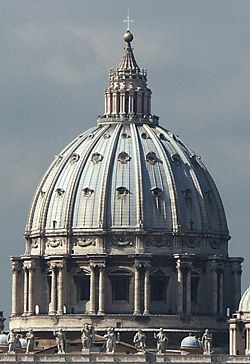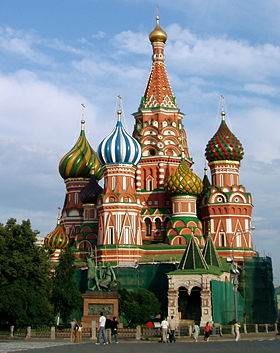Dome

A dome is a structural element of architecture that resembles the hollow upper half of a sphere. The dome has a long architectural history the first domestic domes were recorded as being constructed after the Great Fire of Rome of AD 64, in Nero's Domus Aurea on the slopes of Rome's Palatine Hill. While the dome has been a feature of Muslim architecture since at least the 12th century.
Today, domes are seen as a common feature in ecclesiastical architecture of many varying creeds. Domes became popular in Renaissance Christian architecture from the 15th century onwards, reaching a zenith in popularity during the early 18th century Baroque period. Reminiscent of the Roman senate, during the 19th century they became a feature of grand civic architecture. As a domestic feature the dome is less common, tending only to be a feature of the grandest houses and palaces during the Baroque period.
Many domes particularly those from the Renaissance and Baroque periods of architecture are crowned by a lantern or cupola, which not only serves to admit light, but gives an extra dimension to the decorated interior of the dome.
Contents |
Architectural Description

Domes do not have to be perfectly spherical in cross-section, however; a section through a dome may be an ellipse. If the baseline is taken parallel to the shorter of an ellipse's two diameters, a tall dome results, giving a sense of upward reach. A section across the longer axis results in a low dome, capping the volume instead. A very low dome is classified as a saucer dome. All the surfaces of any dome are curved. A spectacular innovation, one that is at the heart of Baroque style, is the oval dome, which gives axial direction and movement to the space beneath it. Though the oval dome is typically identified with churches of Bernini and Borromini, the first oval dome was erected by Vignola for a chapel, Sant'Andrea in Via Flaminia often called Sant'Andrea del Vignola. Julius III commissioned the dome in 1552 and construction finished the following year.[1] The largest oval dome was built in the basilica of Vicoforte by Francesco Gallo.
Domes that have been disproportionately influential in later architecture are those of the Pantheon in Rome, Hagia Sophia in Istanbul (or in that time Constantinople), and the Dome of the Rock in Jerusalem. In Western architecture, the most influential domes built since the Renaissance have been those of St. Peter's Basilica in Rome and Jules Hardouin-Mansart's dome at Les Invalides in Paris. The dome of St. Paul's Cathedral in London was the inspiration for the United States Capitol in Washington, which in turn inspired domes of most of the US state capitols.
In the 20th century, thin "eggshell" domes of pre-stressed concrete by architect-engineers such as Nervi opened new directions in fluid vaulted spaces enclosed beneath freeform domed space which now might be supported merely at points rather than in the traditional constricting ring.
Characteristics
A dome can be thought of as an arch which has been rotated around its vertical axis. As such, domes have a great deal of structural strength. A small dome can be constructed of ordinary masonry, held together by friction and compressive forces. Larger domes built after Brunelleschi's dome that triumphantly spanned the crossing of Santa Maria del Fiore, the duomo of Florence, have all been built as double domes, with inner and outer shells. [2]

A dome can sit directly on a circular base, however, this is not possible if the base is square. The concave triangular or trapezoidal sections of vaulting that provide the transition between a dome and the square base on which it is set and transfer the weight of the dome are called pendentives. (A less sophisticated version of a pendentive is a squinch.) Under the dome illustrated at left, the pendentives bear circular medallions in bas relief. A pendentive is a constructive device permitting the placing of a circular dome over a square room or an elliptical dome over a rectangular room. The pendentives, which are triangular segments of a sphere, taper to points at the bottom and spread at the top to establish the continuous circular or elliptical base needed for the dome. In masonry the pendentives thus receive the weight of the dome, concentrating it at the four corners where it can be received by the piers beneath. Prior to the pendentive's development, the device of corbelling or the use of the squinch in the corners of a room had been employed. The first attempts at pendentives were made by the Romans, but full achievement of the form was reached only by the Byzantines in Hagia Sophia at Constantinople (6th cent.). In the simple dome the pendentives are part of the same sphere as the dome itself, however such domes are rare. [3] In the more common compound dome the pendentives are part of the surface of a sphere of larger radius than the dome itself but whose center is at a point lower than that of the dome. Another alternative is for a drum to be inserted between the dome and pendentives. Pendentives were commonly used in Byzantine, Renaissance and baroque churches.
A half-dome forms the head of an exedra or its smaller version, a niche. In Late Antiquity, the exedra developed into the apse, with separate developments in Romanesque and Byzantine practice.
Many sports stadiums are domed, especially in climates that have widely-variable summer and winter weather. The first such stadium was the Astrodome in Houston, Texas. A major improvement to the domed stadium was accomplished with the construction of SkyDome, now Rogers Centre, in Toronto, Ontario, the first domed stadium with a retractable roof.
Saucer dome

A saucer dome is the architectural term used for a low pitched shallow dome which is described geometrically as having a circular base and a segmental (less than a semicircle) section. A section across the longer axis results in a low dome, capping the volume. A very low dome is a saucer dome. Many of the largest existing domes are of this shape.
Gaining in popularity from the 18th century onwards, the saucer dome is often a feature of interior design. When viewed from below it resembles the shallow concave shape of a saucer. The dome itself, being often contained in the space between ceiling and attic, is invisible externally. These domes are usually decorated internally by ornate plaster-work, occasionally they are frescoed.
They are seen occasionally externally in Byzantine churches and mosques. Most of the mosques in India, Pakistan, Iran and Afghanistan have these type of domes.
Onion dome

The onion dome resembles more than half of a sphere, exemplified by Saint Basil's Cathedral in Moscow and the Taj Mahal. They are found mostly in eastern architecture, particularly in Russia, Turkey, India, and the Middle East. An onion dome is a type of architectural dome usually associated with Russian Orthodox churches. Such a dome is larger in diameter than the drum it is set upon and its height usually exceeds its width. These bulbous structures taper smoothly to a point, and strongly resemble the onion, after which they are named.
Domes in buildings of worship
Domes also play a very important part in places of worship where they can represent and symbolise different aspects of the religion. Eastern orthodox churches, for example, have domes which represent heaven. The dome's purpose is to remind people that to gain God's blessing it is necessary to accept salvation through Christ. Domes can also be found in Islamic places of worship, called mosques. In an orthodox church the domes have pictures of Jesus whereas in Islam it is forbidden during worship. Instead, mosques have decorations and patterns on the domes. The domes are tradition in Islam, and another reason for domes is so that the building can be distinguished and others can see where it is even from far.
See also
- List of celebrated domes
- List of world's largest domes
External links
- The Dome of Brunelleschi, Florence virtual reality movie and pictures
- "Dome". Catholic Encyclopedia (22.02.2002).
- Structural Assessment of Guastavino Domes
- Architectural Fiberglass domes Stromberg Architectural Domes
- Santa Maria del Fiore high definition
- Domes in stained glass Solarium Design Group Ltd. Toronto, Canada.
References
- ↑ http://roma.katolsk.no/andreavignola.htm
- ↑ Cathedrals are known as duomo in Italian or "dom" in German, not because they possess domes. The term stems from the Latin noun "domus", thus a cathedral is a "domus dei" - a house of God.
- ↑ Sir Banister Fletcher, A History of Architecture. 18th ed. London, Athelone Press(1975) ISBN 0-485550-01-6